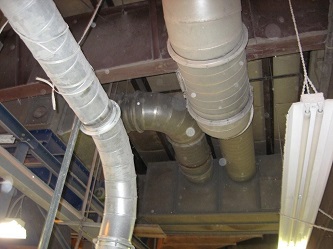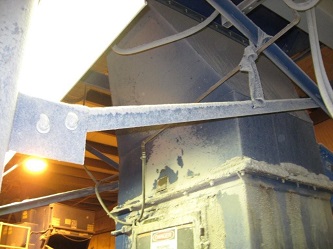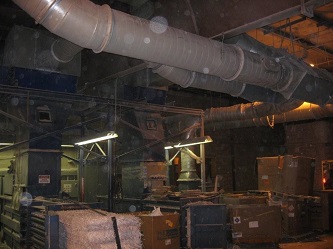Cleaning Scrap Handling Ductwork
Cleaning Scrap Handling Ductwork
 |
 |
 |
“Do I Have to Clean My Scrap Handling Ductwork?” We receive a variation of this question from customers on a regular basis. It is typically asked 3-10 years after the startup of a system or when someone new takes over that is not familiar with the system or its initial design parameters. A facility getting insurance quotes or inspections by third parties such as fire marshals or OSHA also prompts the question. The answers are usually pretty simple. The key difference is what they are asking about … Internal or External Ductwork?
Let’s tackle the Internal Ductwork first… Generally if your system has the properly designed internal air velocity, you should be fine. The action of the material moving through the pipe with the proper line speed of a trim/scrap/dust line will ensure that the inside of most ductwork is kept nice and clean. Of course, this line speed will be dependent on the type and feed rate of the material you are picking up. For example corrugated and paper trim scraps are typically conveyed at about 5,500 fpm (feet per minute). However, at times, heavier scrap like double or triple wall corrugated will need 6,500 fpm. This also goes for slug loads if pulling from equipment such as a hogger or shredder.
For a general rule of thumb… if you aren’t experiencing jams in the duct runs when you are running your full system, you probably are good to go. If there is occasional clogging in elbows or branches… you may not have enough velocity in your line to keep your material moving. Technicians use special testing instruments to determine the speed and force of suction in these areas.
Let us also review the Golden Rules of Air Systems. . . Always be sure your operators start the fan first - then turn on the machine creating the trim. And always make sure the fan is allowed to run for 2-3 minutes after the machine stops generating trim. This prevents material from stopping in the pipe before its destination. Once material is lying flat, or settled in a pipe, it is much more difficult to pick up again. That scenario may contribute to clogging by engaging mechanical friction, and fighting airstream effects, all detrimental to the system. Once this occurs, even on a properly designed system, manually cleaning out lines may be required. There are a couple of instances when you will need to periodically check your ductwork: Dusty Air Going to Collectors and when conveying material with fresh Inks and Coatings.
Cleaning ductwork becomes a concern with inks or coatings. Any time trim is picked up when printing inks or coatings aren’t fully cured, it may end up building up on the inside of the ductwork. This is common in certain binders and grinders in the book industry. Occasionally, the glue gets ground down while it is wet and still setting. The first 30-50 feet of coated ductwork can be described as the way cholesterol builds up in arteries. Most of the time it is far easier to replace pipes in the problem area than clean the duct.
With dusty air headed to collectors, different system designs will operate at different velocities. Problems may occur when multiple fans are used on an air system. If 8 fans are picking up scrap at peak times, but only 4 fans run during change overs or on weekends, dusty air heading to the single collector will experience a 50% loss of velocity - not the most ideal situation. For example, if all of your fans are moving 8” diameter ductwork at 5,500 fpm, that is a total of 15,360 cubic feet per minute of air (cfm). That air would move very nicely in a 23” diameter plenum or duct to the dust collector at 5,500 fpm. Now if we turn off four fans, total cfm cuts down to 7,680 cfm. That same 23” diameter duct work would be conveying about 2,600 fpm. Typically dust is more forgiving on its conveying speed - 3,500 fpm is a good target, although 3,000 fpm will suffice in most instances as well. Clogging may occur if dust slows down and settles to the bottom of the ductwork. When filters become full, resistance and velocity will also change and may contribute to problems. Do a simple and quick visual check on filter ducts whenever changing filters on a dust collector, usually once or twice a year, or when you change operating procedures. (Hint: Quick Fit clamp together ductwork makes this a breeze.)
Now to tackle the real issue in 95% of the cases… External Ductwork Ductwork should be regularly checked for cleaning when it is located externally under the roof. Both the ductwork and roof rafters will collect dust on top. We have encountered facilities that have over 3 inches of dust sitting on top of the rafters. This may result in a serious fire hazard therefore is frowned upon by most inspectors. If you only have a minimal amount of ductwork under roof, the rafters will be more of an issue. The easiest way to remove the dust is to use a scissor lift and either vacuum it off the top of the duct or rafter (use an explosion proof vacuum) or wipe it down manually. Be sure to cover the machines and the material under the ductwork since some of the dust may be knocked down. Avoid blowing dust off with air to avoid distributing to another area causing an additional mess and environmental air issues. There are professional duct and rafter cleaner companies available in many areas. The amount of acceptable dust on top of your rafters or duct may subjective. Thickness of dust can be acceptable at 1/32” deep, or as much as 1/8” depending on substance of the dust and the operations around it. Regular housekeeping habits and documentation are always good practice. The fire marshal always wins. Keep the facility clean.
If you have any questions or would like a professional evaluation, please contact Recycling Equipment Corporation and ask for the service department. We will be happy to help you achieve a facility that offers a clean, safe and compliant environment. REC has specialists for upgades to dust collectors, changes to layout, improving plant effeciency, and fire code compliance.
